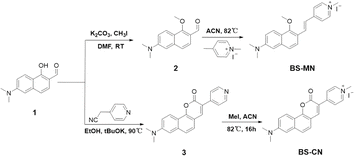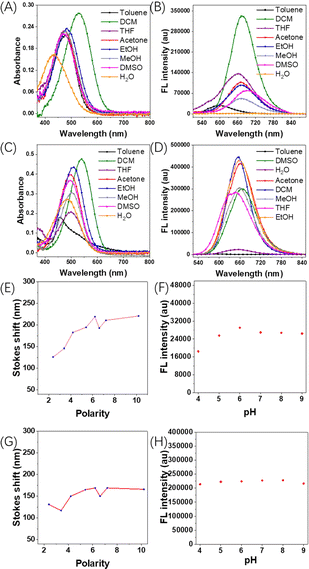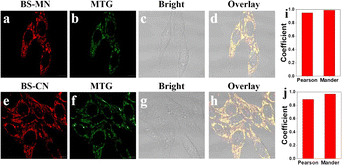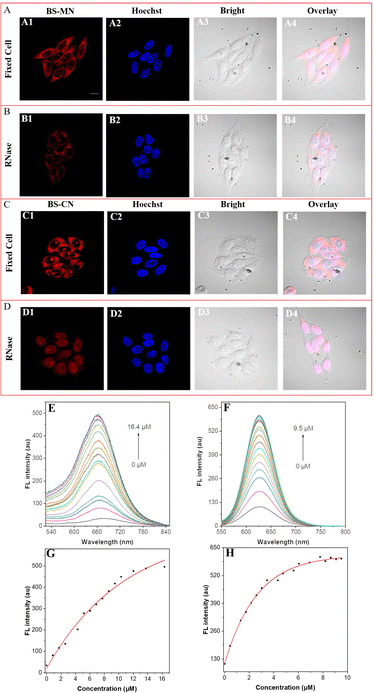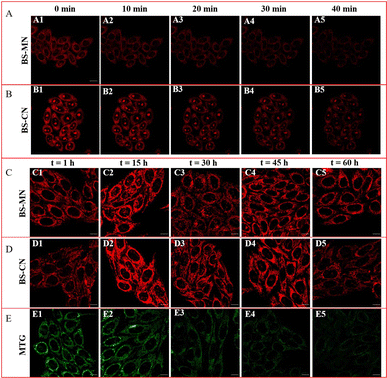 Open Access Article
Open Access ArticleRigidify styryl-pyridinium dyes to benzo[h]coumarin-based bright two-photon fluorescent probes for cellular bioimaging†
Chengjing Zhanga,
Zihao Yub,
Yang Liua,
Wendong Jina,
Zhiqiang Liu *a and
Xiaoqiang Yu
*a and
Xiaoqiang Yu *a
*a
aState Key Laboratory of Crystal Materials, Shandong University, Jinan 250100, China. E-mail: zqliu@sdu.edu.cn; yuxq@sdu.edu.cn
bSchool of Material Science and Engineering, Wuhan University of Technology, Wuhan 430070, China
First published on 28th March 2024
Abstract
Fluorescence imaging of organelles at the cellular level is important for studying biological processes. The development of a highly emissive fluorescent probe that operates under a suitable excitation light source is a key step in high-quality fluorescence imaging. For long-term, high-fidelity fluorescence imaging of mitochondria-related cellular processes using two-photon microscopy and stimulated emission depletion microscopy, we developed a new benzocoumarin-based cationic fluorescent probe (BS-CN) that is far-red emitting, water-soluble, photostable, and very bright in cells. BS-CN showed a remarkably high quantum yield of 0.35 and a large two-photon excited fluorescence action cross-section of 76 GM, enabling the long-term tracking of mitochondria in live cells. In addition, BS-CN exhibited a certain affinity for RNA and stained nucleoli in fixed cells. A comparative assessment of the photophysical properties and bioimaging performance of benzo[h]coumarin-pyridinium and the structurally similar styryl-pyridinium (BS-MN) clearly indicated the importance of structural rigidity for fluorescence efficiency.
1. Introduction
Fluorescence imaging techniques combined with probes with target selectivity provide powerful tools for biological research.1,2 To enhance the quality and resolution of microscopic images, many revolutionary microscopy techniques, such as confocal laser scanning microscopy (CLSM), two-photon laser microscopy, and stimulated emission depletion (STED) microscopy, have been developed.3–5 Generally, these types of microscopy require highly emissive fluorescent probes to label the target and thereby to realize high-quality fluorescence imaging.6Organic fluorescent probes have become increasingly popular owing to their unique advantages, such as good biocompatibility, simple preparation process, low molecular weight, and relatively quick responses.7,8 The luminescence performance and function of probes can be easily tuned by adjusting the molecular structures to meet various requirements.9,10 Many important low-molecular-weight organic fluorescent probes have been developed and commercialized.11 For example, fluorescent probes have been used to identify cancer-related markers, observe the interactions and dynamic changes between organelles in real time, and detect changes in the cell microenvironment (such as polarity, viscosity, and pH).12–15
Mitochondria are membrane-bound organelles that are abundant in the cytoplasm of eukaryotic cells and play important roles in all biological processes (e.g., by generating the chemical energy needed to power biochemical reactions, participating in cell proliferation, and regulating programmed cell death).16–18 Mitochondria are morphologically diverse organelles with substantial variation in size and shape, ranging from small particles to highly filamentous structures.19 Changes in mitochondrial morphology are believed to be closely related to some degenerative diseases in humans, such as Parkinson's disease, Alzheimer's disease, and amyotrophic lateral sclerosis.20 Thus, long-term and high-fidelity visualization and tracking are valuable to understand the roles of mitochondria.
Many mitochondrial fluorescent probes have been developed and applied to record and track the dynamic changes in mitochondria in living cells.21–23 The transmembrane potential of the inner membrane is as high as −180 mV, which distinguishes mitochondria from other organelles.24,25 Therefore, designing probes with a positive charge to target mitochondria is an efficient strategy. Most commercial mitochondrial trackers and conventional mitochondrial probes, either reaction-free or reaction-based, have a cationic moiety that utilizes electrostatic attraction and enhances the targeting affinity to mitochondria.26–29 However, the quantum yields of styryl-pyridinium dyes are generally low.25,27–29 In addition, the nucleolus is an important component of the cell nucleus, and its morphology is related to neurodegenerative diseases, such as Parkinson's disease.30 Recent reports have found that many probes could enter the nucleolus due to the disappearance of the mitochondrial membrane potential.25,31 This facilitates the detection of mitochondrial damage and can be used for analyses of nucleolar morphology in fixed cells.
To fully utilize the advantages of advanced microscopy (e.g., TPM (two-photon microscopy) and STED), such as the high spatial and temporal resolution, non-destructive operation, and long-term time-lapse imaging, the probes must be suitable for far-red emission, sufficient photostability, large nonlinear absorption, compatibility with the excitation laser, and brightness in cells.32–34 Our group has developed a number of fluorescent mitochondrial probes based on the styryl-pyridinium platform with an ultrahigh signal-to-noise ratio and excellent leakage-free performance.35–38 In this study, we designed and synthesized a fluorescent probe for specifically targeting mitochondria for a long time and successfully stained the nucleolus of fixed cells. A comparative study of the photophysical properties and bioimaging performance of benzo[h]coumarin-pyridinium (BS-CN) and a structurally similar styryl-pyridinium (BS-MN) was carried out to determine the importance of structural rigidity for fluorescence efficiency. BS-CN exhibited a remarkably high quantum yield of 35.6%, a large two-photon excited fluorescence (TPEF) action cross-section (δ × Φ) of 76 GM under 900 nm laser excitation, efficient photostability, and compatibility with a 775 nm STED laser. This probe could be used to obtain images of mitochondria without washing at a low concentration of 500 nM with low phototoxicity, avoiding the measurement error caused by self-quenching and auto-fluorescence due to its large Stokes shift (compared with the absorption spectrum, the fluorescence spectrum has a redshift of up to 169 nm), far-red emission, and excellent brightness.
2. Experimental section
2.1. Materials and instruments
Materials and instruments are described in ESI.†2.2. Synthesis of probes
The synthetic routes of BS-MN and BS-CN are shown in Scheme 1,39,40 and characterization data are shown in ESI (Fig. S8 and S19†).![[thin space (1/6-em)]](https://www.rsc.org/images/entities/char_2009.gif) :
:![[thin space (1/6-em)]](https://www.rsc.org/images/entities/char_2009.gif) 1 to 3
1 to 3![[thin space (1/6-em)]](https://www.rsc.org/images/entities/char_2009.gif) :
:![[thin space (1/6-em)]](https://www.rsc.org/images/entities/char_2009.gif) 1) to give compound as a bright yellow solid (840 mg, 73% yield based on 6-(dimethylamino)-1-hydroxy-2-naphthaldehyde). 1H NMR (400 MHz, DMSO-d6), δ (ppm): 10.32 (d, J = 6.4 Hz, 1H), 8.04 (d, J = 9.3 Hz, 1H), 7.58 (d, J = 8.7 Hz, 1H), 7.47 (d, J = 8.8 Hz, 1H), 7.29 (dd, J = 9.4, 2.6 Hz, 1H), 6.98 (d, J = 2.6 Hz, 1H), 4.06 (s, 3H), 3.09 (s, 6H). 13C NMR (100 MHz, DMSO-d6), δ (ppm): 188.75, 163.23, 151.25, 140.49, 124.78, 123.09, 123.04, 121.02, 119.03, 116.61, 106.02, 65.95, 40.32. HRMS (ESI) m/z calcd for [C14H16NO2+] 230.1136 ([M + H]+), found 230.1178.
1) to give compound as a bright yellow solid (840 mg, 73% yield based on 6-(dimethylamino)-1-hydroxy-2-naphthaldehyde). 1H NMR (400 MHz, DMSO-d6), δ (ppm): 10.32 (d, J = 6.4 Hz, 1H), 8.04 (d, J = 9.3 Hz, 1H), 7.58 (d, J = 8.7 Hz, 1H), 7.47 (d, J = 8.8 Hz, 1H), 7.29 (dd, J = 9.4, 2.6 Hz, 1H), 6.98 (d, J = 2.6 Hz, 1H), 4.06 (s, 3H), 3.09 (s, 6H). 13C NMR (100 MHz, DMSO-d6), δ (ppm): 188.75, 163.23, 151.25, 140.49, 124.78, 123.09, 123.04, 121.02, 119.03, 116.61, 106.02, 65.95, 40.32. HRMS (ESI) m/z calcd for [C14H16NO2+] 230.1136 ([M + H]+), found 230.1178.![[thin space (1/6-em)]](https://www.rsc.org/images/entities/char_2009.gif) :
:![[thin space (1/6-em)]](https://www.rsc.org/images/entities/char_2009.gif) 1 to 70
1 to 70![[thin space (1/6-em)]](https://www.rsc.org/images/entities/char_2009.gif) :
:![[thin space (1/6-em)]](https://www.rsc.org/images/entities/char_2009.gif) 1) to give compound as a reddish brown solid (99 mg, 35% yield based on 6-(dimethylamino)-1-hydroxy-2-naphthaldehyde). 1H NMR (400 MHz, DMSO-d6), δ (ppm): 8.67 (dd, J = 4.6, 1.5 Hz, 2H), 8.57 (s, 1H), 8.23 (d, J = 9.3 Hz, 1H), 7.86 (dd, J = 4.6, 1.6 Hz, 2H), 7.61 (s, 2H), 7.38 (dd, J = 9.4, 2.5 Hz, 1H), 7.05 (d, J = 2.5 Hz, 1H), 3.12 (s, 6H). 13C NMR (100 MHz, CDCl3), δ (ppm): 160.34, 152.41, 150.68, 149.93, 142.96, 142.68, 137.60, 124.21, 123.94, 123.37, 122.47, 120.88, 115.96, 114.36, 111.67, 105.61, 40.34. HRMS (ESI) m/z calcd for [C20H17N2O2+] 317.1285 ([M + H]+), found 317.1261.
1) to give compound as a reddish brown solid (99 mg, 35% yield based on 6-(dimethylamino)-1-hydroxy-2-naphthaldehyde). 1H NMR (400 MHz, DMSO-d6), δ (ppm): 8.67 (dd, J = 4.6, 1.5 Hz, 2H), 8.57 (s, 1H), 8.23 (d, J = 9.3 Hz, 1H), 7.86 (dd, J = 4.6, 1.6 Hz, 2H), 7.61 (s, 2H), 7.38 (dd, J = 9.4, 2.5 Hz, 1H), 7.05 (d, J = 2.5 Hz, 1H), 3.12 (s, 6H). 13C NMR (100 MHz, CDCl3), δ (ppm): 160.34, 152.41, 150.68, 149.93, 142.96, 142.68, 137.60, 124.21, 123.94, 123.37, 122.47, 120.88, 115.96, 114.36, 111.67, 105.61, 40.34. HRMS (ESI) m/z calcd for [C20H17N2O2+] 317.1285 ([M + H]+), found 317.1261.![[thin space (1/6-em)]](https://www.rsc.org/images/entities/char_2009.gif) :
:![[thin space (1/6-em)]](https://www.rsc.org/images/entities/char_2009.gif) 1) to give BS-MN as a brown solid (54 mg, 28% yield based on 6-(dimethylamino)-1-methoxy-2-naphthaldehyde). 1H NMR (400 MHz, DMSO-d6), δ (ppm): 8.79 (d, J = 6.8 Hz, 2H), 8.25 (d, J = 6.8 Hz, 2H), 8.15 (d, J = 16.4 Hz, 1H), 7.97 (d, J = 9.3 Hz, 1H), 7.80 (d, J = 8.9 Hz, 1H), 7.54–7.47 (m, 2H), 7.28 (dd, J = 9.3, 2.5 Hz, 1H), 7.00 (d, J = 2.4 Hz, 1H), 4.25 (s, 3H), 3.97 (s, 3H), 3.08 (s, 6H). 13C NMR (100 MHz, DMSO-d6), δ (ppm): 157.32, 153.33, 150.18, 145.25, 138.18, 135.26, 124.42, 124.12, 123.62, 123.46, 119.87, 119.85, 116.67, 106.42, 64.22, 47.19, 44.23. HRMS (ESI) m/z calcd for [C21H23N2O+] 319.1805 ([M–I]+), found 319.1794.
1) to give BS-MN as a brown solid (54 mg, 28% yield based on 6-(dimethylamino)-1-methoxy-2-naphthaldehyde). 1H NMR (400 MHz, DMSO-d6), δ (ppm): 8.79 (d, J = 6.8 Hz, 2H), 8.25 (d, J = 6.8 Hz, 2H), 8.15 (d, J = 16.4 Hz, 1H), 7.97 (d, J = 9.3 Hz, 1H), 7.80 (d, J = 8.9 Hz, 1H), 7.54–7.47 (m, 2H), 7.28 (dd, J = 9.3, 2.5 Hz, 1H), 7.00 (d, J = 2.4 Hz, 1H), 4.25 (s, 3H), 3.97 (s, 3H), 3.08 (s, 6H). 13C NMR (100 MHz, DMSO-d6), δ (ppm): 157.32, 153.33, 150.18, 145.25, 138.18, 135.26, 124.42, 124.12, 123.62, 123.46, 119.87, 119.85, 116.67, 106.42, 64.22, 47.19, 44.23. HRMS (ESI) m/z calcd for [C21H23N2O+] 319.1805 ([M–I]+), found 319.1794.2.3. Living cells culture
HeLa cells were cultured in the H-DMEM culture medium containing 10% fetal bovine serum (FBS) and 1% penicillin/streptomycin in an incubator containing 5% CO2 at 37 °C for 36 h. Then, added the probes and Hoechst 33342 into the culture medium and incubated for 30 minutes and 10 minutes respectively. For co-localized imaging, we added the probes and MitoTracker Green into the culture medium and incubated for 30 minutes.2.4. Fixed cell experiment
HeLa cells were fixed with cold 4% paraformaldehyde for 2.5 h, then washed away by PBS (phosphate buffer saline), and treated with 0.5% TritonX-100 for 5 min, after that washed with PBS. The cells were subsequently incubated with probes for 20 minutes. Subsequently, Hoechst 33342 (2 µM) was added and incubated for an additional 10 minutes before imaging. We fixed the cells in the same way, then treated with RNase (5 mg mL−1) for 2 h. Finally, the cells were incubated with probes for 20 min, and Hoechst 33342 (2 µM) for 10 min before imaging.2.5. Photostability
The cells were incubated with BS-CN (500 nM)/BS-MN (1 µM) for 30 min, and imaged by CLSM. By continuous scanning to extract pictures of 0, 10, 20, 30, 40 minutes.2.6. Long-time tracking
The cells were incubated with BS-CN (500 nM)/BS-MN (1 µM) for 30 min, changed the culture medium every 36 h and imaged at 1 h, 15 h, 30 h, 45 h and 60 h.2.7. pH experiment
Britton–Robison standard buffer solution (pH = 2) was diluted with NaOH solution to prepare the needed solutions with pH of 4, 5, 6, 7, 8 and 9. The pH value of the solution was checked using a pH meter. Then the probe was added into the solutions to measure the fluorescence intensity.3. Results and discussion
3.1. Design and synthesis
In this study, we developed novel fluorescent probes that target mitochondria in living cells and stain fixed cells. We first designed BS-MN, which incorporated an electron-rich dialkylamino group as an electron-donating group (D) and an electron-withdrawing pyridinium as an electron-accepting group (A). We used styryl-naphthalene instead of styryl-benzene as a conjugated bridge (π) to extend the emission band to the deep-red and NIR region. This design resulted in excellent push–pull electronic effects within the molecular structure of D–π–A. Endogenous substances in cells may destroy the double bond structure in BS-MN, and the influence of the isomerization of carbon–carbon double bonds on the molecular structure as well as the increase in non-radiative transitions due to the rotation of a single bond led to a reduction in the fluorescence emission efficiency and strength of intracellular imaging. Therefore, we synthesized BS-CN by constructing a rigid ring via intramolecular esterification to enhance the fluorescence performance and stability of the probe. This effectively reduced the single-bond rotation within the molecule.3.2. Photophysical properties
The absorption and emission spectra were measured in various solvents. As shown in Fig. 1, both BS-CN and BS-MN showed maximum absorbance at 470–510 nm and 474–490 nm, respectively. Emission peaks of BS-CN and BS-MN were observed at 650–670 nm and 655–685 nm, respectively. The optical properties of BS-CN and BS-MN in various solvents are listed in Table S1.† The probes exhibited large Stokes shifts of 117–169 nm for BS-CN and 126–221 nm for BS-MN. BS-CN showed higher molar extinction coefficients and fluorescence quantum yields than those of BS-MN in all tested solvents. As shown in Fig. 1E and G, BS-CN exhibited a more stable Stokes shift than that of BS-MN with changes in polarity. These results indicated that BS-CN possessed superior photophysical properties. Moreover, changes in intracellular polarity did not affect the imaging capability of the probe.Meanwhile, we found that the fluorescence quantum yields of most reported styryl-pyridinium dyes were generally low,25,27–29 and this resulted in staining only at a high concentration, which may cause damage to cells (Table S2†). We synthesized BS-CN with reasonable rigidity, which improved its molecular planarity and fluorescence quantum yield. Remarkably, the fluorescence quantum yield reached an astonishing 35.6%, allowing accurate mitochondrial imaging at a low concentration of 500 nM.
To study the effects of pH, the stability of BS-CN was investigated under different pH conditions (Fig. 1F and H). We found that BS-CN had almost no spectral change at pH 4.0–9.0; however, BS-MN had a little spectral change in pH 4.0–5.0 (Fig. S1†). This demonstrated that stability is higher for BS-CN than for BS-MN across a range of pH values.
We investigated the two-photon properties of the probes using Rhodamine B as a reference. BS-CN and BS-MN had TPEF action cross-sections (δ × Φ) of 76.7 GM and 7.9 GM (1 GM = 10−50 (cm4 s) per photon) upon excitation at 1050 nm (Fig. S2†). These results demonstrate that BS-CN exhibits superior two-photon performance compared with those of BS-MN and similar previously reported compounds.35
3.3. Confocal fluorescence imaging
Prior to fluorescence imaging, we examined the cytotoxicity of BS-CN and BS-MN in live cells using a standard MTT assay. HeLa cells growing in log phase were seeded into 96-well plates and incubated with the two probes at different concentrations for 24 h. Based on the results of the MTT assay (Fig. S3†), no significant decrease in cell viability was observed after the addition of BS-CN or BS-MN for 24 h. BS-CN exhibited negligible cytotoxicity in HeLa cells, and BS-MN showed slightly lower cytotoxicity. Next, we performed fluorescence imaging experiments by CLSM. The commercial nuclear marker Hoechst 33342 was used to determine cellular uptake (Fig. S4†).41 Living HeLa cells were stained with 500 nM BS-CN/BS-MN for 30 min, and bright filaments in the cytoplasm were distinctly observed only in the group stained with BS-CN. This phenomenon was observed in the group stained with BS-MN at 1 µM. This is because BS-CN had a higher fluorescence quantum yield than that of BS-MN. Based on our experience and previous reports, we speculate that BS-CN/BS-MN targets mitochondria in living cells. Owing to the spectral crosstalk between our probes and commercial MitoTracker Deep Red (MTDR), we evaluated this conjecture by co-staining experiments with commercial MTG (Mito-Tracker Green) in HeLa cells. As shown in Fig. 2, BS-CN and BS-MN overlapped well with MTG; the Pearson co-localization coefficients were 0.89 and 0.95 and the Manders' overlap coefficients were 0.97 and 0.99, respectively. These data revealed that the probes were located exclusively in the mitochondria of living cells.3.4. The response of BS-CN and BS-MN to RNA
As shown in Fig. 2, BS-CN stained a small area of the nucleus. Therefore, we speculated that BS-CN may be RNA-selective. RNA titration experiments were conducted (Fig. 3E and F). As the RNA content increased, the fluorescence intensities of the two probes gradually increased and ultimately stabilized. After adding 9.5 µM and 16.4 µM RNA, the fluorescence intensities of BS-CN and BS-MN increased approximately 5.6 times and 16 times, respectively. These results indicate that BS-CN and BS-MN have affinity for RNA. The significant enhancement of fluorescence in BS-MN could be explained by the restriction of intramolecular rotation when BS-MN was bound to RNA.As shown in Fig. S5,† the fluorescence intensities of BS-CN and BS-MN did not increase significantly in various cationic and anionic solutions, but were significantly enhanced in the RNA stock solution (1 mM, dissolved in PBS). This result indicated that the two probes had higher selectivity for RNA. Next, we conducted staining experiments on the fixed cells using the two probes. As shown in Fig. 3A and C, BS-CN and BS-MN stained the nucleoli and cytoplasm. We speculated that the two probes stained RNA in the fixed cells because RNA was mainly distributed in the cytoplasm and nucleoli. For BS-CN, the fluorescence intensity in the nucleoli of fixed cells was significantly higher than that in living cells. Compared with BS-MN, BS-CN stained the nucleolus more clearly and brightly. The cells were then treated with RNase and stained with BS-CN and BS-MN (Fig. 3B and D). BS-CN did not stain the nucleoli and cytoplasm but was localized in the nucleus, indicating that BS-CN binds to DNA in the nucleus only after RNA ablation. However, similar results were not obtained for BS-MN. Therefore, BS-CN may be used as a nucleolar probe. Furthermore, to demonstrate the abilities of BS-CN and BS-MN to bind RNA, we conducted molecular docking analyses. Due to the hydrogen bonding interactions, BS-CN exhibited better bonding ability than that of BS-MN, as evidenced by their docking free energies (−8.46 kcal mol−1 and −7.25 kcal mol−1, respectively), as shown in Fig. S6.†
3.5. Photostability and long-time tracking ability of BS-CN and BS-MN
Photostability is a crucial property for fluorescence probes in bioimaging applications, especially in long-term tracking.42 Photo-bleaching is a common problem in many organic fluorescence probes and limits the temporal monitoring of dynamic intracellular processes. To test the stability of the probes under continuous laser scanning, we performed imaging using CLSM for 40 min. As shown in Fig. 4A and B, after 40 min of laser scanning, BS-CN still had a higher fluorescence intensity than those of the two probes, whereas the fluorescence intensity of BS-MN decreased significantly. Our experiments demonstrated that BS-CN exhibited stronger anti-photobleaching ability than that of BS-MN.To test the stability of both probes over extended periods, we performed imaging for various time intervals ranging from 1 to 60 h using 500 nM BS-CN and 1 µM BS-MN. As shown in Fig. 4C and D, both BS-CN and BS-MN maintained their high brightness for a long time while targeting the mitochondria of HeLa cells. In contrast, the fluorescence brightness of the commercial MTG decreased significantly over time (Fig. 4E). After 60 h of staining, we used these cells for co-localization experiments with BS-CN and BS-MN (Fig. S7†). Notably, both BS-CN and BS-MN displayed good overlap with MTG, with Pearson co-localization coefficients of 0.81 and 0.88, respectively. These findings highlight the relative stability of BS-CN and BS-MN, as they remained within the cells without being expelled during cellular metabolism. These probes may be helpful for high-resolution and delayed mitochondrial monitoring in future research.
4. Conclusion
In summary, we designed and synthesized fluorescence probes, BS-MN and BS-CN, using a strategy for conferring rigidity through intramolecular esterification to improve the molecular structure. BS-CN, based on benzo[h]coumarin, exhibited a higher photobleaching resistance and fluorescence quantum yield and lower staining concentration than those of BS-MN. Both probes exhibited precise mitochondrial targeting in live cells, enabling long-term tracking and imaging for up to 60 h. Importantly, after cell fixation, the mitochondrial membrane potential diminished, causing the migration of BS-CN from the mitochondria to the nucleoli and allowing for clear staining of the nucleoli. In conclusion, these two probes serve as powerful tools for the long-term tracking of mitochondria in live cells, and BS-CN may be an effective nucleolar probe for tissue imaging.Author contributions
Chengjing Zhang: conceptualization, methodology, investigation, data curation, writing–original draft. Zihao Yu: investigation, data curation. Yang Liu: investigation, data curation, formal analysis. Wendong Jin: data curation, investigation. Zhiqiang Liu: resources, funding acquisition, supervision, writing–review & editing. Xiaoqiang Yu: resources, funding acquisition, writing–review & editing.Conflicts of interest
There are no conflicts to declare.Acknowledgements
This work was supported by National Natural Science Foundation of China (U2330106 and 52350002), and the Fundamental Research Funds for the Central Universities (2022JC003).References
- H. Cheng, Y. Li, B. Tang and J. Yoon, Chem. Soc. Rev., 2020, 49, 21–31 RSC.
- T. Kowada, H. Maeda and K. Kikuchi, Chem. Soc. Rev., 2015, 44, 4953–4972 RSC.
- G. Lukinavičius, L. Reymond, E. D'Este, A. Masharina, F. Göttfert, H. Ta, A. Güther, M. Fournier, S. Rizzo, H. Waldmann, C. Blaukopf, C. Sommer, D. Gerlich, H. Arndt, S. Hell and K. Johnsson, Nat. Methods, 2014, 11, 731–733 CrossRef PubMed.
- Y. Xu, R. Xu, Z. Wang, Y. Zhou, Q. Shen, W. Ji, D. Dang, L. Meng and B. Tang, Chem. Soc. Rev., 2021, 50, 667–690 RSC.
- L. Wu, J. Liu, P. Li, B. Tang and T. James, Chem. Soc. Rev., 2021, 50, 702–734 RSC.
- X. Liu, B. Yu, Y. Shen and H. Cong, Coord. Chem. Rev., 2022, 468, 214609 CrossRef CAS.
- J. Lin, K. Yang and E. J. New, Org. Biomol. Chem., 2021, 19, 9339–9357 RSC.
- Y. Huang, Y. Zhang, F. Huo, Y. Wen and C. Yin, Sci. China: Chem., 2020, 63, 1742–1755 CrossRef CAS.
- G. Niu, W. Liu, H. Xiao, H. Zhang, J. Chen, Q. Dai, J. Ge, J. Wu and P. Wang, Chem.–Asian J., 2016, 11, 498–504 CrossRef CAS PubMed.
- Y. W. Jun, H. R. Kim, Y. J. Reo, M. Dai and K. H. Ahn, Chem. Sci., 2017, 8, 7696–7704 RSC.
- N. I. Georgiev, V. V. Bakov, K. K. Anichina and V. B. Bojinov, Pharmaceuticals, 2023, 16, 381 CrossRef CAS PubMed.
- C. Zong, Q. Lu, J. Niu, F. Meng and X. Yu, Spectrochim. Acta, Part A, 2023, 299, 122883 CrossRef CAS PubMed.
- S. Wang, W. X. Ren, J. T. Hou, M. Won, J. An, X. Chen, J. Shu and J. S. Kim, Chem. Soc. Rev., 2021, 50, 8887–8902 RSC.
- Q. Wang, Z. Li, Y. Hao, Y. Zhang and C. Zhang, Anal. Chem., 2022, 94, 17328–17333 CrossRef CAS PubMed.
- L. Guo, M. Tian, Z. Zhang, Q. Lu, Z. Liu, G. Niu and X. Yu, J. Am. Chem. Soc., 2021, 143, 3169–3179 CrossRef CAS PubMed.
- S. Fulda, L. Galluzzi and G. Kroemer, Nat. Rev. Drug Discovery, 2010, 9, 447–464 CrossRef CAS PubMed.
- L. Galluzzi and G. Kroemer, Cell, 2008, 135, 1161–1163 CrossRef CAS PubMed.
- M. Khacho, R. Harris and R. S. Slack, Nat. Rev. Neurosci., 2018, 20, 34–48 CrossRef PubMed.
- X. Zhang, Q. Sun, Z. Huang, L. Huang and Y. Xiao, J. Mater. Chem. B, 2019, 7, 2749–2758 RSC.
- A. M. Aleardi, G. Benard, O. Augereau, M. Malgat, J. C. Talbot, J. P. Mazat, T. Letellier, J. Dachary-Prigent, G. C. Solaini and R. Rossignol, J. Bioenerg. Biomembr., 2005, 37, 207–225 CrossRef CAS PubMed.
- W. Liu, Q. Qiao, J. Zheng, J. Chen, W. Zhou, N. Xu, J. Li, L. Miao and Z. Xu, Biosens. Bioelectron., 2021, 176, 112886 CrossRef CAS PubMed.
- X. Li, J. Zheng, W. Liu, Q. Qiao, J. Chen, W. Zhou and Z. Xu, Chin. Chem. Lett., 2020, 31, 2937–2940 CrossRef CAS.
- Z. Lv, Z. Man, H. Cui, Z. Xu, H. Cao, S. Li, Q. Liao, Q. He, L. Zheng and H. Fu, Adv. Funct. Mater., 2021, 31, 2009329 CrossRef CAS.
- L. D. Zorova, V. A. Popkov, E. Y. Plotnikov, D. N. Silachev, I. B. Pevzner, S. S. Jankauskas, V. A. Babenko, S. D. Zorov, A. V. Balakireva, M. Juhaszova, S. J. Solott and D. B. Zorov, Anal. Biochem., 2018, 552, 50–59 CrossRef CAS PubMed.
- J. Niu, S. Yang, M. Tian and X. Yu, Sens. Actuators, B, 2022, 372, 132693 CrossRef CAS.
- M. Y. Wu, K. Li, Y. H. Liu, K. K. Yu, Y. M. Xie, X. D. Zhou and X. Q. Yu, Biomaterials, 2015, 53, 669–678 CrossRef CAS PubMed.
- W. Niu, L. Guo, Y. Li, S. Shuang, C. Dong and M. S. Wong, Anal. Chem., 2016, 88, 1908–1914 CrossRef CAS PubMed.
- F. Miao, W. Zhang, Y. Sun, R. Zhang, Y. Liu, F. Guo, G. Song, M. Tian and X. Yu, Biosens. Bioelectron., 2014, 55, 423–429 CrossRef CAS PubMed.
- P. S. Deore, D. S. Coman and R. A. Manderville, Chem. Commun., 2019, 55, 3540–3543 RSC.
- C. Y. Y. Yu, W. Zhang, R. T. K. Kwok, C. W. T. Leung, J. W. Y. Lam and B. Z. Tang, J. Mater. Chem. B, 2016, 4, 2614–2619 RSC.
- M. Tian, J. Sun, B. Dong and W. Lin, Sens. Actuators, B, 2019, 292, 16–23 CrossRef CAS.
- T. Liu, T. Stephan, P. Chen, J. Keller-Findeisen, J. Chen, D. Riedel, Z. Yang, S. Jakobs and Z. Chen, Proc. Natl. Acad. Sci. U. S. A., 2022, 119, e2215799119 CrossRef CAS PubMed.
- M. Ishigaki, M. Iketani, M. Sugaya, M. Takahashi, M. Tanaka, S. Hattori and I. Ohsawa, Mitochondrion, 2016, 28, 79–87 CrossRef CAS PubMed.
- F. Chen, W. Liu, H. Li, T. Deng, B. Xing and F. Liu, Analysis Sensing, 2022, 2, e202100066 CrossRef CAS.
- G. Zhang, Y. Sun, X. He, W. Zhang, M. Tian, R. Feng, R. Zhang, X. Li, L. Guo, X. Yu and S. Zhang, Anal. Chem., 2015, 24, 12088–12095 CrossRef PubMed.
- R. Yang, X. He, G. Niu, F. Meng, Q. Lu, Z. Liu and X. Yu, ACS Sens., 2021, 6, 1552–1559 CrossRef CAS PubMed.
- L. Guo, H. Liu, X. Jin, Z. Zhang, J. Su and X. Yu, Sens. Actuators, B, 2021, 341, 129962 CrossRef CAS.
- J. Fu, J. Niu, Q. Hao, F. Meng, C. Zong, X. He, Z. Liu and X. Yu, Dyes Pigm., 2023, 216, 111352 CrossRef CAS.
- H. Xiong, L. He, Y. Zhang, J. Wang, X. Song and Z. Yang, Chin. Chem. Lett., 2019, 30, 1075–1077 CrossRef CAS.
- Z. Fang, Y. Wang and Y. Wang, Org. Lett., 2019, 21, 434–438 CrossRef CAS PubMed.
- M. Cao, T. Zhu, M. Zhao, F. Meng, Z. Liu, J. Wang, G. Niu and X. Yu, Anal. Chem., 2022, 94, 10676–10684 CrossRef CAS PubMed.
- K. Devarajan, M. Sivakalai, S. M. Basu, C. Biswas, M. Chauhan, U. Hasan, Y. Panneerselvam, U. M. Narayanan, S. S. K. Raavi, J. Giri and T. K. Panda, Biomater. Sci., 2023, 11, 3938–3951 RSC.
Footnote |
| † Electronic supplementary information (ESI) available. See DOI: https://doi.org/10.1039/d3ra08269e |
| This journal is © The Royal Society of Chemistry 2024 |

